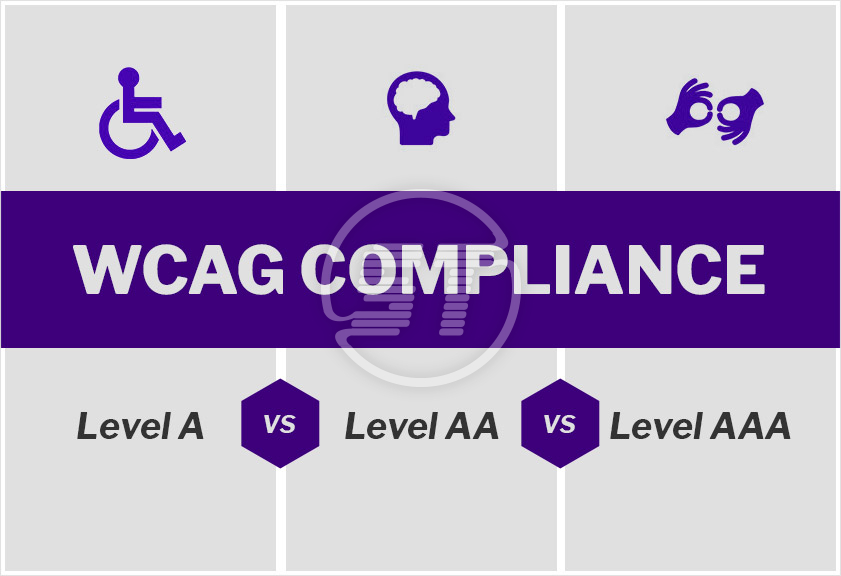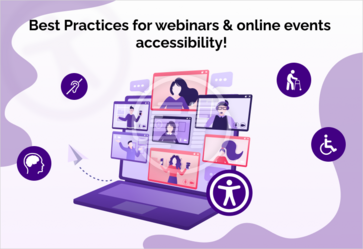Web Content Accessibility Guidelines (WCAG) are a set of rules that make the web more accessible to everyone. It is published by World Wide Web Consortium (W3C) to make the regulations readily available to people who are creating websites.
These best practices increase the quality of your website and make it accessible and usable to not only people with disabilities but to everyone.
WCAG released different versions or levels of regulations in order to provide a fully accessible solution to all the users. The three levels of this compliance are A, AA, and AAA. These levels are distinct, yet you need to learn about them carefully. The levels are meant to enhance the flexibility and quality of the websites. Even complex designs can maintain the compliance rules using these levels.
The three conformance levels are a decisive factor in your website's success. Also, they impact the design to the core. The more higher level, the more impact on design. They leave their impression on designs for the benefit of your website.
Let’s know more about these WCAG compliance level A, AA, and AAA:
Conformance levels of WCAG
- Level A – It is the minimum level. A site should have at least level A guidelines to become accessible.
- Level AA – This is an evolved level that includes requirements of level A and additional guidelines of AA. Many organizations try to achieve at least this level in order to be accessible to everyone.
- Level AAA – This one is a higher level. It has level A, AA, and AAA requirements. The new websites that are being created from scratch using this level to be fully accessible.
Difference among level A, AA, and AAA
To make WCAG easy to understand for every organization, its information is divided into three levels. So that organizations can work around the guidelines and create accessible web development assets for everyone. These levels are A (minimal conformance), AA, and AAA (maximum conformance).
The levels are different from each other, but people may get confused. To make them clear, we tried curating the levels here more straightforwardly. Let’s have a look at them.
Level A
This one is the minimal compliance option for every website. This level focuses on the primary mistake organizations do while creating a website that make websites inaccessible to people with some disabilities.
Level A guidelines that should get followed by organizations:
- Alt text for images is compulsory.
- For pre-recorded audio-only or video-only media, provide a descriptive transcript to make it understandable.
- Headings should be nested appropriately.
- ARIA labels should be there at specific places to make them recognizable.
- Don’t use div and span; rather, use real elements like links and buttons.
- Content should be in a meaningful way.
- Content shouldn’t be based only on shape, size, color, sound, or other sensory characteristics.
- If using color for words, background, or links, provide its information in the text.
- Avoid including audio or video in content that plays automatically.
- Make sure the user can navigate the content using only keyboard as well.
- There should be pause, stop, hide for moving elements like, videos and animations.
- Never use such an element that blink more than three times in 1 second.
- Don’t give irrelevant links.
- Give descriptive labels in form fields or use ARIA-described by to include help text in forms.
Level AA
It is the most common and acceptable level. Many websites aim to achieve level AA to qualify the WCAG and ADA compliance. In this level, websites follow all the requirements mentioned in level A and additional requirements of this level.
- Captions are needed for live audio and video. Also, videos should include narration for better reach.
- Device orientation should not be the problem for content. It should be available in both horizontal and vertical forms on all devices.
- The color contrast of text is 4.5:1, for text and image 3:1, and the text size should be a minimum of 16px.
- Content on hover or focus should appear adequately and should not overlap other content.
- The website should contain any of these - a table of contents, sitemap, or a list of related pages.
- Headings and labels of each page should be unique.
- Keyboard focus should be highly visible, and visible elements should have focused all the time if using the keyboard.
- The same component on a web page should appear in a consistent order.
- To convey a status message, use ARIA live regions or ARIA alert to make it understandable for screen readers.
- Web forms should have accurate labels and navigation.
Level AAA
This is the high-level accessibility conformance. To achieve this level, an ADA compliant website design should be created with all the technical considerations and robust tools. You should have all the significant resources to meet the expectations of this level. It has all the previously mentioned (Level A and AA) guidelines and many more additional regulations.
- Streaming media should have sign language interpretation and accurate audio description.
- Try to avoid including background audio on the website.
- Text and images of text ought to have the color contrast of 7:1.
- Hyperlinks should be self-identifying to their destination.
- Section headings should present content in a more specific way.
- Every action on the website can be performed using a keyboard only.
- Color switcher and text resizer should be available on the site.
- A thesaurus is needed in website to give the meaning of abbreviations, idioms, unusual words, or technical terms.
- Flashing blocks of contents is not advisable.
- There should be no time limit imposed on the user. They should be able to browse the website the way they like to.
- The reading level of text on a web page should not be highly advanced.
Read WCAG 2.1 Quick Reference document for detailed information of these guidelines.
WCAG Compliance levels improve your content!
These levels assist in improving the overall quality of your website. Eventually, you get the benefits of search engine optimization and higher retention and conversion. To achieve the accessibility goal, you should apply the guidelines and do proper testing to check the outcome.
However, WCAG is flexible and applicable in various situations, yet you ought to be careful while applying these rules to avoid any blunder. With legal approval, your site can be accessible to more people on the web. It will help your business grow and soar high.
Moreover, explore the difference between WCAG 2.0, 2.1, and 2.2 checklist:

Download WCAG 2.0, 2.1 and 2.2 checklist now Or watch this video to understand its difference in detail and improve your digital assets’ compliance with the latest WCAG standards.
Is your website, web application, documents, mobile application accessible for people with disabilities? With a team of experts, we provide complete ADA web accessibility services including audit, strategy, design, and development services that comply with accessibility regulations such as ADA, WCAG 2.0, 2.1, 2.2 and Section 508 within your budget. Get in touch with us at hello@skynettechnologies.com or submit the following request free quote form.


